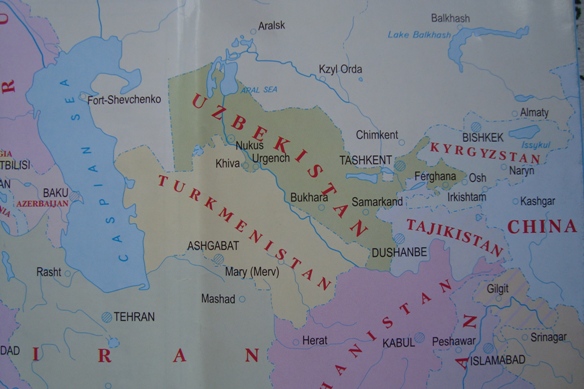Since we‘ ve been in Samarkand Uzbekistan , the golden road to Samarkand
 Once upon a time there was a Sogdian empire of Persion origin from about 700 BC till 700 AD. They already had irrigation, fountains in the cities and a sewage system! Which we didn’t even have in
Once upon a time there was a Sogdian empire of Persion origin from about 700 BC till 700 AD. They already had irrigation, fountains in the cities and a sewage system! Which we didn’t even have in  In 329 BC Alexander the Great remarked, when seeing its capital Samarkand, after his famous crossing of the river Oxus (now the Syr Daria, the river which is the southern border to
In 329 BC Alexander the Great remarked, when seeing its capital Samarkand, after his famous crossing of the river Oxus (now the Syr Daria, the river which is the southern border to
Around 640 AD the Islam was brought here (to Transoxiana as they called it) by no one less than the cousin of Mohammed himself. It was a rough time! Either you turned Moslim or died, or at best became a slave. The city of Bukhara
After the Arab empire weakened, a true Golden Age followed under the Samanyid rulers from 900- 1100, attracting the finest intellectuals of the time. The irrigation networks were expanded, the population of Bukhara grew to 300.000, more than in soviet times, and Bukhara
Below: the now restored wall of the Citadel of Bukhara, the city within a city where the Emir resided. Bukhara is now a Unesco heritage.
The once beautiful city of Bukhara was razed to a level plain. Everything was demolished, apart from the beautiful Kalon(Grand tower, to the right, detail directly below), the mausoleum of Ismael Samani -at that time hidden in desert below, and the Magok–I-attari Mosk
 .
. Each of these buildings have a remarkable architecture, and decorations, still without colours, but made by a variety of brick patterns.
Each of these buildings have a remarkable architecture, and decorations, still without colours, but made by a variety of brick patterns.
Interesting to discover are the very old culture symbols like the circles ( the Zoroastrian sun) Swastika, th flower of life, and the yin-yang symbol.
Around 1500 Abdullah Khan reunited the Uzbek clans and prepared the gound for Bukhara ’s 2d golden age. Craftsmen abducted from Herat (Afghanistan
To the left a Caravanserai: notice the entrance being high enough for laden camels to pass through!
 To the right is another mausoleum, mainly beautiful from the outside. The picture at the bottom shows the cupola of one of the Mosks from the inside.
To the right is another mausoleum, mainly beautiful from the outside. The picture at the bottom shows the cupola of one of the Mosks from the inside.
Around 1600 Bukhara
Between 1600 and 1800 there was a strong decline, as overland routes withered since the Dutch, British and Portugese were operating a succesfull sailing route to the spice islands and China.











Geen opmerkingen:
Een reactie posten